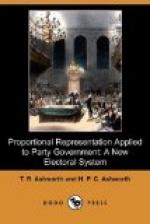FOOTNOTE:
[7] Hobart Mercury
CHAPTER VII.
FREE LIST SYSTEM OF PROPORTIONAL DELEGATION.
The Liste Libre, or Free List system, is a far simpler and more practical method of proportional representation than the Hare system. The distinctive feature is that it applies the proportional principle not to individual candidates but to parties. But, like the Hare system, it places no restriction on the number of parties. It is therefore particularly adapted to the circumstances of the countries on the Continent of Europe, which, having already a number of strong party organizations, wish to retain them and to do justice to each. Accordingly we find that nearly all experiments in proportional representation to the present time have been confined to those countries.
Perhaps the very earliest attempt to apply the proportional principle was that of Mr. Thomas Gilpin, in a pamphlet, “On the Representation of Minorities of Electors to act with the Majority in Elected Assemblies,” published at Philadelphia in 1844. He proposed that electorates should be enlarged, and that each party should nominate a list of candidates equal to the number required to be elected, and should place them in order of preference. Each elector could then vote for one of these lists; and each party would be allotted a number of representatives proportional to the amount of support it received. The highest on each list, to the number allotted, would be elected. It will be seen that this is really a system of double election; for the order of favour of the candidates of any party would have to be decided before the nominations were made.
Only two years afterwards M. Victor Considerant published a similar scheme at Geneva, Switzerland. Each elector was to vote first for a party and then for any number of candidates on the party list whom he preferred. The party votes were to decide the number of members allotted to each list, and the individual votes the successful candidates.




